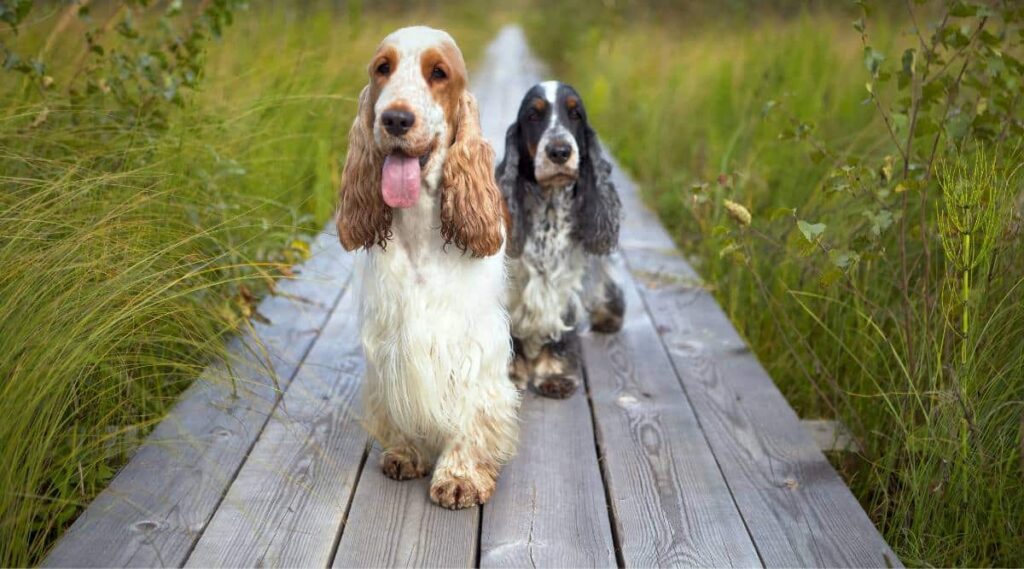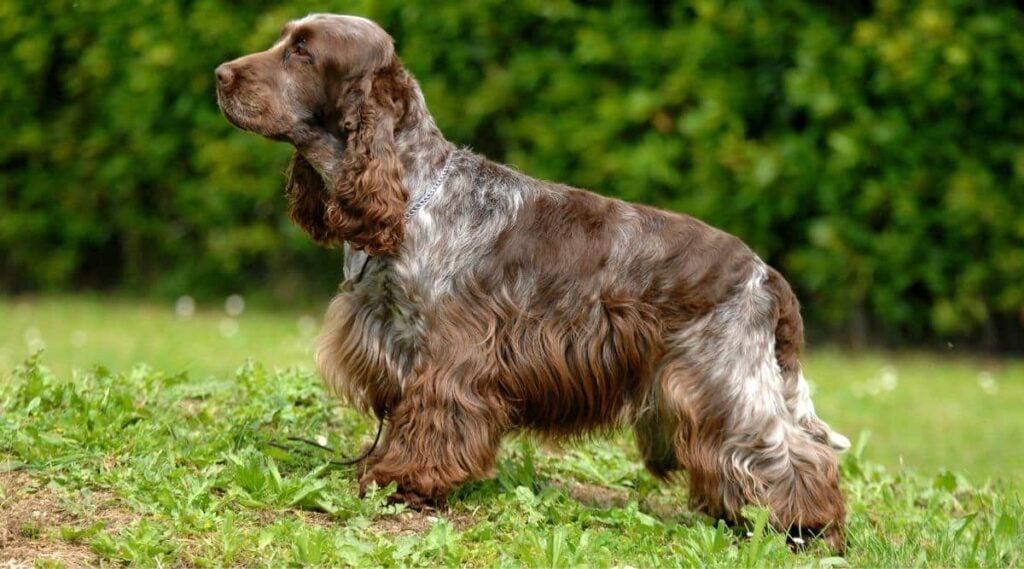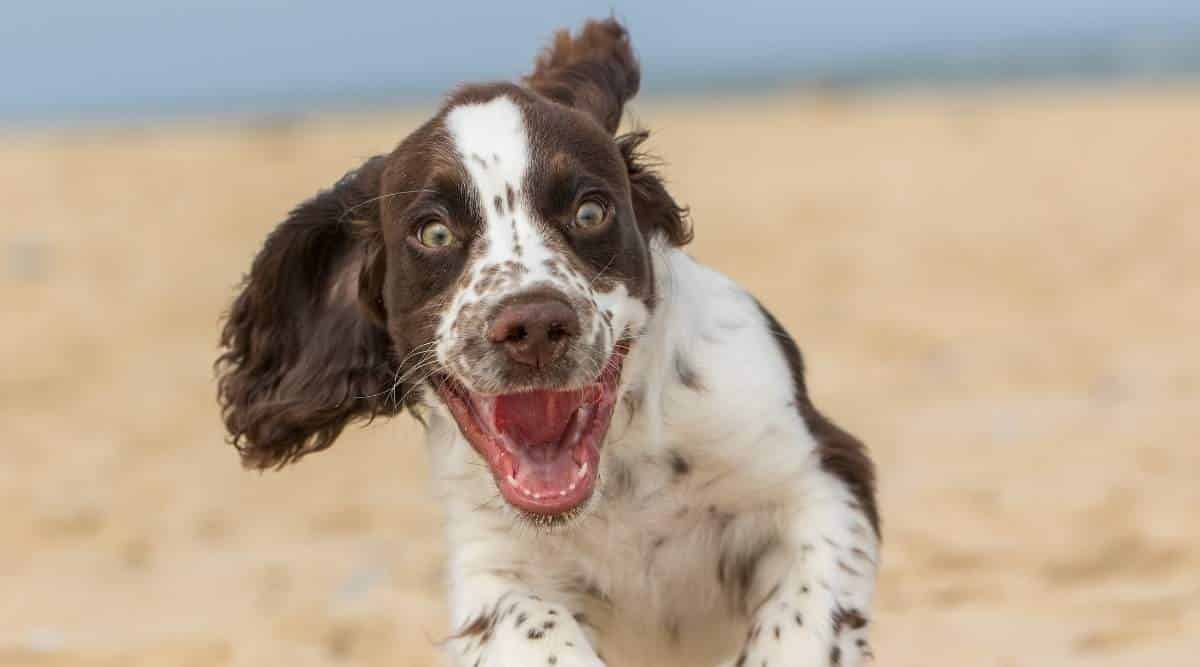English Cocker Spaniel: Facts, Traits, Pictures & More
When you purchase through links on our site, we may earn a commission. Here’s how it works.
The adjectives used to describe the English Cocker Spaniel include merry, athletic, and intelligent. The English Cocker Spaniel was originally developed to hunt woodcock – large, short-legged wading birds that are primarily nocturnal and spend most of the day in dense cover. English Cockers are larger dogs than their American cousins. Leggier and built to hunt and retrieve, the English Cocker is a quick study and ideal sport dog.
Temperamentally, English Cocker Spaniels are optimistic and eager to please, making them excellent family companions as well. Only recognized as a separate breed from the American Cocker by the AKC in 1936, the English Cocker Spaniel was bred for different hunting purposes and for specific colors. British breeders crossed in roan and parti-color spaniels to add their characteristics to the breed.
The English Cocker (EC), often nicknamed the “Merry Cocker,” was once the most popular breed in the United States, widely appreciated for its fun and merry disposition. One of the breed’s most endearing traits is his soulful and trustworthy expression.
Table of Contents
Breed History

Spaniels are generally considered the oldest sporting type of gun and bird dogs. Hunters developed the spaniel to help them catch feathered game. These dogs were classified by how they hunted. Pointers and setters pointed and flushed birds, while retrievers brought downed birds back to the hunter.
The word spaniel is derived from Spanish, and the earliest English spaniels were derived from Spanish stock centuries ago. Spaniels were divided into types – water spaniels and land spaniels. Bird hunters used dogs to augment their use of nets, bows, and falcons. The land spaniels were subdivided again by size.
The larger spaniels were springing and field spaniels, while the smaller spaniels specialized in flushing the game bird known as the woodcock. These small spaniels became known as the Cocker Spaniel. During the Victorian Era, the types of spaniels were officially categorized, and the English Cocker Spaniel became a breed.
Temperament
The English Cocker Spaniel‘s blend of eagerness to please and willingness to follow commands in the field make him an ideal family companion. English Cockers are easy to train with positive reinforcement. Their gentle nature doesn’t handle rough treatment or training methods. ECs have a steady personality and are gentle with children and even cats if well socialized. They may not be trustworthy around the family chickens because they retrieve birds.
With a disposition often described as merry, English Cockers thrive on human companionship. English Cockers make good house dogs but need mental stimulation because of their working nature. Dogs who get too little exercise and mental stimulation will alleviate their boredom, for better or worse.
Size & Appearance
Although English Cockers are medium-sized dogs, they are athletic and strong for their size. Males are 16 to 17 inches tall and weigh 28 to 34 pounds. Females are slightly smaller and more feminine at 15 to 16 inches tall and 26 to 32 pounds.
The standard for the English Cocker Spaniel focuses on the “balance” inherent in the breed. Short-coupled and compactly built, an English Cocker can quickly cover the ground and dive through the underbrush. Although the breed is solid with plenty of bone, they are never coarse.
The EC’s characteristic head is strong but softly contoured. His wide-set, dark, kind eyes with their soft expression are endearing. Low-set ears extend to his chin and are covered with silky straight or slightly wavy hair. A strong jaw allows him to carry the game handily, and his well-padded muzzle is cushioned to hold the birds.
Coat & Colors

The EC’s silky coat protects him as he crashes through the underbrush to retrieve birds. The hair on the English Cocker’s head is short and sleek, but it is medium length overall on his body. The longer hair on his ears may be straight or slightly wavy. He’s a feathered breed, but the texture of his coat is smooth enough not to interfere with work in the field.
English Cockers come in many striking colors. Black and tan and liver and tan are considered solid colors but also may be the basis of a parti-color coat, as can the other solids. Parti-color coats are clearly ticked, marked, or roaned. His pattern will mix the white with the base colors of black, liver, or red. Solid markings should be broken up and as evenly distributed on the body as possible.
Living Conditions
Although the English Cocker is a sporting dog who needs plenty of exercise, he craves affection and interaction. English Cockers are best kept as indoor dogs with access to a securely fenced yard or at least 30 minutes of brisk exercise two or three times per day.
Training
English Cockers are highly trainable. People pleasers by nature, English Cockers learn commands quickly and seek positive reinforcement. Although their hunting ability is largely a breed characteristic, their biddability makes them naturals for sports like agility.
Health

Although they are overall healthy and happy dogs, English Cockers have some genetic predispositions. While some of the conditions to which English Cockers are predisposed are minor, there are a few that could drastically diminish his lifespan.
Progressive Retinal Atrophy
If your dog appears to be losing eyesight and has no visible cataracts, he may have Progressive Retinal Atrophy. PRA is particularly troubling because it is asymptomatic until significant loss of sight has already occurred. Your buddy may be unwilling to go into a dark room or bump into things in a new environment, and his retinas may seem shinier than usual If you notice your dog acting like he cannot see well, make an appointment to screen him. Unfortunately, there is currently no cure for PRA, but you can modify his environment to make things easier for him.
Patellar Luxation
If your dog is limping, he may be experiencing a dislocated kneecap or patellar luxation. Patellar Luxation is usually a genetic condition affecting small breeds. Your dog may hold a leg up for a few steps as he runs but then switches back to using it normally again. This condition can lead to stiffness and arthritis later in life, and treatment varies with the severity of the disease. While mild cases of patellar Luxation may be treated with NSAIDs to alleviate discomfort, severe cases generally require surgical intervention.
Cataracts
Cataracts tend to appear with age, and English Cockers have a higher incidence of them. While surgery is an option for this disease with its recognizable cloudy appearance, many elderly dogs adjust to blindness as long as their owner makes accommodations.
Joint Dysplasia
English Cocker Spaniels can suffer from hip dysplasia, a painful condition in many breeds today. Feeding your puppy for steady but slower growth may help avoid this condition. Any potential breeding dog should have an Orthopedic Foundation for Animals (OFA) or PennHIP Evaluation, and buyers should seek puppies from parents with good evaluation results.
Juvenile Onset Renal Failure
English Cocker Spaniels are susceptible to a congenital abnormality that causes juvenile renal (kidney) disease. Dogs show signs of chronic renal failure, stunted growth, dysphagia, and loss of appetite. The onset of renal failure generally occurs between three months and three years, with around one year of age being the most typical. A problem in a particular collagen network crucial for long-term maintenance of standard structure and function of the glomerular capillary wall isn’t properly formed. When this collagen network is not formed correctly, the GBM deteriorates and initiates a process of progressive renal injury that leads to chronic renal failure. An autosomal recessive hereditary glomerulopathy occurs in English Cocker Spaniels worldwide.
Hearing Loss
Although parti-color English Cockers are particularly beautiful, this color pattern does predispose them to a higher incidence of deafness than many other breeds. The most common cause of hereditary deafness is cochleosaccular and associated with coat color patterns. Parti-color English Cockers are twice as likely to be congenitally deaf, which means they are deaf from birth. Dogs with hearing loss can make excellent pets, but they do startle easily. You’ll have to adjust how you handle your dog to accommodate his condition.
Hypothyroidism
When your dog does not produce sufficient thyroid hormone for his body to function as it should, the proper term for his condition is hypothyroidism (hypo means under, so this means thyroid under normal levels). Symptoms of hypothyroidism are similar to those in humans, including lethargy, hair loss, changes in behavior, and obesity. Your veterinarian may prescribe a hormone supplement to balance your pup’s deficiency.
Nutrition
Choose a dog food specific to the life stage your dog happens to be in. Growing pups have different nutrient requirements than mature or senior dogs. Follow the feeding chart on the feed bag or can, but monitor your dog’s weight. When juvenile dogs grow quickly, they can be more susceptible to problems like joint dysplasia. Even though English Cocker Spaniels are active dogs, they can become obese and suffer health issues related to obesity.
Depending on activity level, your dog may eat between one and one and a half cups twice a day as an adult, although this will vary depending on his activity level. A working dog needs more calories than one with a more sedentary lifestyle. A high-quality kibble including meat protein, fiber, healthy carbs, omega-3 fatty acids, vitamins, and minerals that meet AAFCO standards is a good choice for all life stages.
The most common allergens in commercial dog food are wheat gluten, eggs, soy, beef, chicken, and lamb. Food allergies in dogs can cause both digestive upset and itchy skin. See your veterinarian if your dog is not maintaining body weight or if itchy skin and ears make you suspect he may have food allergies. Your vet may recommend a diet free from the most common allergens as your pup’s skin heals. You should be able to find a blend that keeps your buddy healthy and happy at a price point you can live with.
Grooming
The English Cocker Spaniel’s luxurious coat requires daily maintenance. Their feathered coat is silky and smooth but can pick up debris, especially considering the English Cocker’s job in the field. Brush him daily with a pin brush. Once a week, he may need a run-through with a stripping comb to help brush loose hairs out of his coat to minimize what he leaves behind.
As weather allows, you may bathe your English Cocker once every four to six weeks with a shampoo and conditioner made specifically for dogs. To make his feathers easier to detangle, use a detangling spray or rinse. English Cockers need the same nail and dental care as other dog breeds. Be sure to work with their nails and brush their teeth when they are pups to make the job easier as they reach adulthood.
Breeders And Puppy Costs

When you begin your search for an English Cocker pup, find a reputable breeder willing to guarantee their pups’ health and temperaments. English Cocker Spaniels cost between $800 and $2,000. Insist on seeing proof of the parent dogs’ health certificates. Because parti-color dogs have a risk of congenital deafness BAER testing, a hearing test for animals, is recommended to determine whether a pup is congenitally deaf.
Rescues & Shelters
English Cocker-specific rescue organizations are familiar with the breed’s needs and are a great way to find your new best friend. Rescue centers are located around the country, and most states have rescues dedicated to the breed. They can assist you in searching for the perfect family addition. You can also search online through Petfinder.com for English Cocker Spaniels in your area.
As Family Pets
In general, this breed is:
- Friendly and merry.
- Attractive with a kind eye.
- Suited to family life.
- High-energy and athletic.
- Healthiest with about an hour total of daily exercise.
- Good with children if socialized properly.
- May be destructive when bored.
- Best in a home with a large yard unless you can otherwise meet his exercise needs.
- May chase feathered pets unless raised with them.
Final Thoughts
If you’re looking for a lovely, kind-hearted companion, the English Cocker Spaniel is a perfect fit. This cheerful and energetic dog is an excellent canine family member. If you are looking for a companion with great beauty and outstanding character that can keep up with your athletic lifestyle, the English Cocker Spaniel may be your perfect companion.



